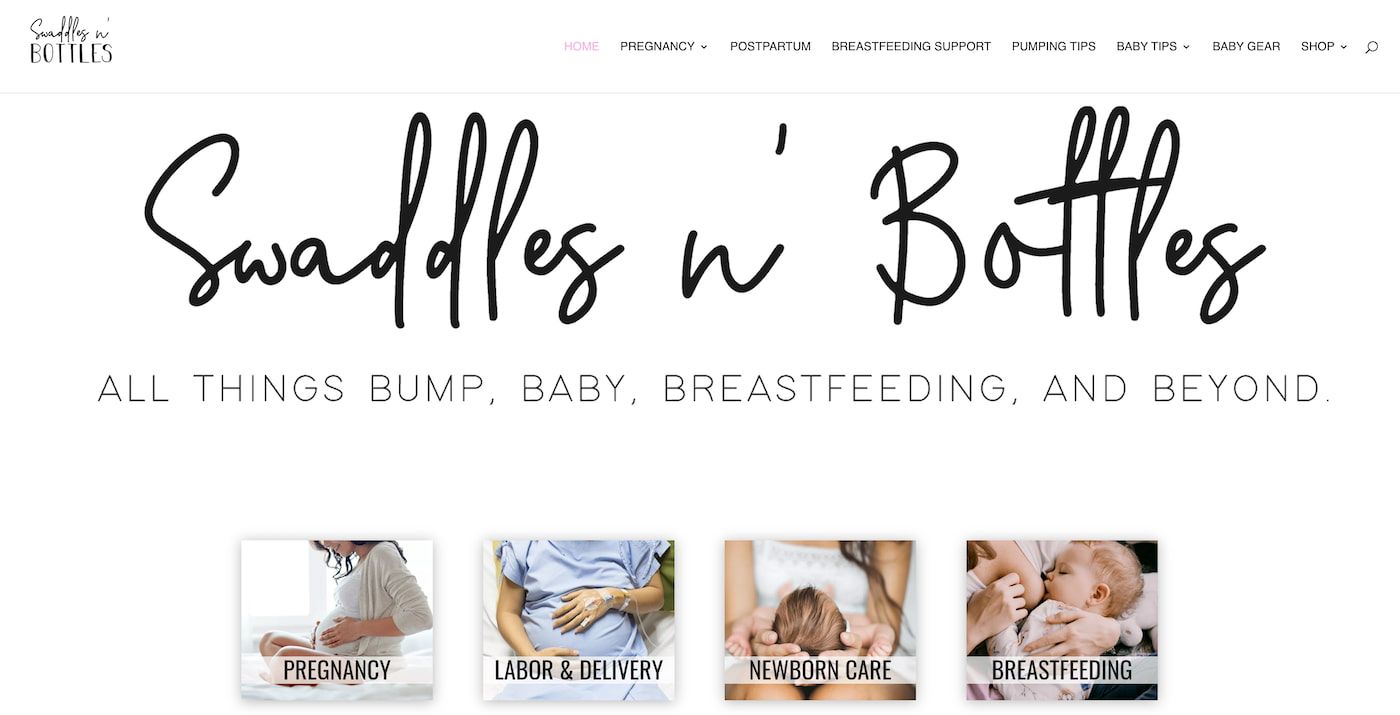How To Start A Mom Blog That Makes Money In 2024

By Stefani Anderson
Updated: May 01, 2023

Learning how to start a mom blog can seem daunting, but it's easier than ever, thanks to user-friendly website builders.
These platforms cover everything from helping you to create a visually pleasing blog to generating revenue through sponsored posts and e-commerce.
Read on as we break down everything you need to know to start a mom blog and build a following of loyal readers through engaging content.
Why Start A Mom Blog?
Becoming a mom blogger is an excellent way to share your knowledge with other moms and build lasting relationships through ongoing conversations.
With excellent website builders like Friday making it easier than ever before to start a blog, it doesn't have to be a headache putting together a new blog.
If you're a mother looking to make money, mom blogs are among the easiest ways to bring in income from the comfort of your home.
The best blogging jobs for moms can generate a respectable revenue stream through different sources, from writing a sponsored post to selling merchandise.
It can also be developed at your own pace, so you can write one post a week or commit to several a week, depending on your schedule.
Successful Mom Blog Examples
Before you get started blogging, it's important to spend some time researching the best mom blogs to see how successful websites build their content.
With thousands of mom blogs online, knowing where to begin this research can be difficult, so we've compiled a few examples to get you started.
Check out these mom blogs to see the kind of content that works well and the different visual styles that offer a pleasing-to-the-eye experience.
1. What Moms Love

What Moms Love is a hugely popular mom blog offers exceptional content with a gorgeous aesthetic and is particularly popular among new mothers.
The blog is broken down into several core categories, including babies, kids, gear, and food ideas, with several writers contributing to the content.
There's also a long list of handy guides for mothers that bring additional value to the table and competes with some of the best lifestyle blogs around.
2. The Journey Of Parenthood

The Journey of Parenthood blog takes a more personal approach to its content and features blog posts about the creator's family experiences.
With plenty of colorful photographs and stories about family occasions, it's a great blog that inspires parents looking for their next adventure.
A beautifully arranged mom blog with plenty of content, its online store will inspire new bloggers to offer high-quality merchandise.
3. Swaddles 'N' Bottles

If you're looking for inspiration from mom blogs aimed at new mothers, then Swaddles 'n' Bottles has plenty of content to give you ideas.
It covers everything from advice for busy moms dealing with newborn care to breastfeeding tips and healthcare recommendations.
The home page is intuitively arranged with lots of visual interest, while the blog posts are articulately written with actionable information to add value.
How To Start A Mom Blog In 2024 (Step-By-Step)
We've researched all aspects of putting together a mom blog in this guide so that you can start blogging and create exciting and unique content.
This includes researching other mom blogs and choosing your niche, and writing your first posts to promote on social media.
Here's everything you need to know about starting a mom blog that makes money in 2024:
Step 1: Choose Your Niche
With thousands of mom bloggers on the internet, it's crucial that you host unique and interesting content that makes your blog stand out from the crowd.
This means finding your niche so that your mom blog sets itself apart, attracting a core audience of followers who share your interests.
You should identify a particular target audience based on your expertise and interests rather than attempting to cover all aspects of motherhood.
While the mommy blog concept in and of itself is relatively niche, a massive range of topics fit within this category.
Before you commit to building your mom blog, you should research a range of mom blog niche ideas and see what inspiration you can find.
Whether your blog covers online safety or posting recipe suggestions, this research will throw up plenty of helpful tips on making your blog successful.
This may also help you to hone in on the niche which best suits your experiences, drawing on what works with a successful blog as inspiration for your content.
There are profitable blogging niches that explore a broad range of subjects, including:
- Breastfeeding
- Childhood nutrition
- Fashion
- Education
- Sensory play
- Parenting advice
Once you're clear on your blog's niche, brainstorm blog post ideas you think will fit into this topic and develop a vision of how your blog will look.
Step 2: Pick Your Blogging Platform
With your niche chosen, it's time to select the best blogging platform where you can host your content and start building a presence.
Several free blogging platforms are available to set up a mom blog quickly, but these offer limited services and won't allow you to monetize content.
Additionally, a free blogging platform will feature intrusive advertisements that detract from your presence, which generate revenue for the host but not yourself.
Many mom bloggers start with a new WordPress blog, and it's easy to install WordPress and get started blogging using a free domain name.
It's a popular choice, but plenty of other hosting platform options are worth considering that allow you to build a blog with ease.
These platforms replicate services such as choosing a WordPress theme and refining it with a selection of tools, offering more user-friendly interfaces suited to beginners.
When researching the various hosting service platforms available, take into account the following factors:
Price
Most mom bloggers want to keep their costs as low as possible when first setting out on their blogging journey, particularly as it's unlikely to generate revenue from day one.
Check the monthly fee for the hosting services and what each subscription package offers regarding features and support.
Self-Hosted Blog Content
One of the key factors to consider is the extent to which you have complete control and ownership of your content, which is something free a blogging platform won't cover.
By setting up a self-hosted blog, you'll avoid the rare but very real risk of your site potentially being shut down if the host platform closes down or decides to shut down your blog for any reason.
Starting with a self-hosted blog guarantees that your content is safe from these risks and that all copyright ownership belongs to you.
Services & Tools
Different blog hosting platforms offer various tools and services to help you get your website up and running.
They also utilize different systems that users can access to build their blog, from simple drag-and-drop tools to easily add text and assets to more complicated systems requiring some website coding knowledge.
If you don't have any experience in this domain, try to find a blogging platform that allows for easy content creation and avoid those which require some coding knowledge and multiple plug-ins.
Monetization Options
Once your mom blog picks up speed and gains traffic, you'll want to be able to make money with your website in a variety of ways.
This could include an online store where you can sell merchandise or work with affiliates to promote products related to your niche.
Make sure the hosting platform you opt for allows you to monetize in these ways, and check to see what revenue you can expect if you decide to generate income through adverts.
The ideal hosting platform allows users to build upon compelling and visually exciting templates to fill out their website with a range of blogging tools.
This means that once you're fully immersed in the blogging world, you'll be able to run a profitable mom blog that allows you to make money blogging.
Step 3: Choose Your Blog's Name
With your hosting platform of choice and your mommy blog niche decided, it's time to choose a catchy and relevant name for your blog.
Website hosting platforms such as the Friday website builder offer plenty of inspirational templates that can give you some ideas for choosing a great name.
This name should grab the reader's attention and make a strong impression while clarifying what your blog covers.
Using alliterations, such as "Bouncing Babies" or "Modern Mothers," is an effective technique to help make the name more memorable, as is using rhyming words.
Your blog's name is also closely linked to the branding for your website, so you should avoid choosing a long name that might be difficult to visualize in your assets.
Instead, keep it short and sharp so that your followers don't struggle to recall it, checking your research to see how it compares to other popular mom blogs.
If you're struggling to come up with a name, name generator tools such as Instant Domain Search will offer suggestions based on your ideas.
Run your blog name ideas by friends and family; once you've settled on the name, it's time to purchase your domain name and sign up for a hosting platform.
Step 4: Buy Your Domain Name & Hosting
Checking to see if your chosen name is available for a domain is incredibly easy by simply typing your name into a domain registration platform.
Different domain names have different values, and these services will give you various pricing options based on their desirability.
This price is also affected by the type of domain name, with a dot com address typically more expensive than other website URLs such as dot org.
Mommy bloggers living outside the United States can use a URL ending specific to their country of origin, such as a .co.uk for the United Kingdom.
In addition to choosing a service to purchase your domain name, you'll need to pick a hosting platform where your assets are stored online.
If you've already opted for a blogging platform such as Friday, this will already be covered in their service, saving you the trouble of setting one up.
Not only do such platforms include custom domains that are fully compatible with all domain registrars, but they also incorporate hosting via Amazon Web Services.
This means you can upload as much content as your blog requires without worrying about your video and image assets being compromised due to bugs or hackers.
By using a comprehensive blog hosting platform that includes domain name registration and hosting, you're free to focus on writing blog posts and creating eye-catching content.
Step 5: Choose Your Theme & Branding
Great blog posts and informative content will only reach a large audience if it has eye-catching branding that captures the essence of what you're about.
This is where the various website templates offered by the best blog hosting platforms come in, allowing you to choose from themes to use as a starting point.
For example, using one of the Friday templates will give you a pre-designed website layout to drag and drop your assets easily.
This means you can avoid the time-consuming tasks typically associated with building a website and starting a blog.
These templates cover a broad range of businesses, including online baking stores, education services, fashion boutiques, and templates for mom bloggers.
All the core elements of a great blog are laid out and ready to go with these templates, including:
- Menus and other navigation links to help visitors orient themselves when exploring your blog
- Relevant pages, such as the home page, contact and blog pages, biography, and your online store
- Essential widgets covering features such as image galleries and sliders, social media sharing buttons, and "Click to Call" icons
- Basic page elements, including columns and text boxes that can be populated with assets using the drag-and-drop functions
- Page elements such as banner and heading spaces where logos and other branding designs can be added to the template
These templates can also be viewed across a range of device formats, allowing you to check how they look on mobile devices, tablets, and desktop PCs.
Once you've selected a template, you can start building up the core branding elements that will give your blog a consistent and professional look.
These branding assets include a basic logo and any banner and background images you wish to appear throughout each page.
If you don't have experience creating logos, you can find freelance graphic designers for a reasonable fee on platforms such as Fivver and Upwork.
For mommy bloggers setting up with little to no budget, it's worthwhile asking around your friends and family to see if you can find someone to help for free.
Alternatively, there are several online logo-creator tools that you can use to create a professional-looking logo in a matter of minutes.
Try to avoid creating a logo crammed with too much detail and lots of colors since this logo should look clear even when viewed on smaller smartphones.
Instead, keep it clean and simple with 2-3 colors and a bold design that stands out at a glance and sets your blog apart from the competition.
Once you've designed your logo, you can use the same colors to build up the other elements of your blog and maintain a consistent style across all pages.
This includes paying attention to which fonts you use for your blog posts and building upon the core aspects of the template for a professional aesthetic.
Step 6: Design & Write Essential Pages
When researching the most successful bloggers and seeing how they structure their websites, you'll notice that each includes several essential pages.
These pages provide the core structure for your blog website, which visitors can use to navigate quickly to the content they're most interested in reading.
Let's take a closer look at these essential pages you need to include and the things you should consider before you design and write up this content.
Home Page
The most important page for a successful mom blog is the Home page, the first page any visitor will see that should be designed to make an immediate impression.
The Home page should instantly tell the visitor what your blog is about and the content you're offering, with links to your latest posts and stimulating visuals.
A great Home page should also act as a one-stop resource for a range of content; if you have an online store, there should be links to your newest products.
If you're running any sales or promotions, these should be among the first thing visitors see when they land on your Home page.
It can also feature a news feed and trending content so visitors can jump straight to recent and popular content offering the best value.
If your blog is affiliated with a company or hosting sponsored posts to generate revenue, these should also be featured prominently on your Home page.
About Page
While your home page may include a few sentences describing your particular niche, the About page is where you can expand on this in detail.
The About page is a combination of your biography and an outline of your business model, explaining your journey and the area of expertise you're focusing on.
It can be used to explain your professional background and how this relates to your blog's niche and profile other bloggers who are contributing content.
The About page is where your personality can shine through, so keep the tone informative and welcoming.
At the same time, ensure you've made it clear what the site's overall goal is and the long-term value you're offering.
Contact Page
Including a Contact page on your mom blog is essential if you want to engage with your audience and foster meaningful and lasting relationships.
This page takes minimal effort to set up and can be as basic as providing an email address your visitors can use to send you queries.
If you don't have a separate email address dedicated to your website, you can include a contact form requiring users to input their name, email address, and message.
You can also include the following contact information:
- Company address
- Phone number
- The map location of your business
- Social media buttons
The Contact page can also list frequently asked questions you receive from followers, saving you time responding to common inquiries.
You can also consider including a mailing list option, which can be used to promote new products and update followers on the latest content.
Privacy Policy
Finally, if you're setting up a blogging business, your website will need to include a Privacy Policy to explain how visitors' personal data is handled.
The privacy policy page is a necessary feature of any website that gives visitors informed consent and shows that the site complies with Cookie Policy/Cookie Law.
It serves as a legal document that fully discloses the methods used by a website for collecting, processing, storing, sharing, and protecting user data.
A privacy policy can be quickly set up using one of many privacy policy generator tools that deliver a template you can add to your blog.
Mommy blogs that feature e-commerce stores, where additional personal information such as full name and payment details is gathered, are legally bound to provide a privacy policy.
While the legality of privacy policies varies from country to country, most have strong data protection and privacy legislation that should be adhered to.
In the United States, privacy and data protection legislation can vary from state to state, so research the requirements in your area when building your website.
Fortunately, there are plenty of free templates available online that you can use to fill out your privacy policy without unnecessary stress.
Step 7: Do Keyword Research & Plan Your Blog
Before you start writing blog posts, you must perform keyword research to ensure this content is optimized to reach as many potential followers as possible.
Keywords are single words or short expressions that search engine algorithms view more favorably than others.
Choosing the best keywords is essential for increasing your chances of ranking high in search results for a given term.
Keyword research is a fundamental aspect of search engine optimization (SEO), where the search terms used by people are identified and used in a website's content.
The best keywords will depend on the niche subject of your blog.
For example, if you focus on nutrition, terms such as "popular baby nutrition" and "healthy eating for kids" are more likely to generate positive results.
There are many tools you can use to research keywords and choose the best ones for your posts to increase the blog traffic you receive.
By inputting your core keywords into these tools, they will generate hundreds of related keywords and search terms that you can use to enhance your SEO.
These tools also exploit Google's Autocomplete feature, which predicts what search terms people use as they type in the search box.
Analyzing this information helps you to put together the most relevant terms for your content and reach those most interested in reading it.
Once you've compiled a collection of individual and longtail keywords that relate to your niche, you can use these to plan the content for your blog.
An effective way to do this is to brainstorm all the associated topics related to your particular niche, then group these into subcategories.
You can then start to organize the order to write this content so that your blog posts tell a compelling story over time as you post them online.
If you're struggling to find the time needed to outline and write your blog content, you can create a stay-at-home mom schedule to help manage your time.
Step 8: Write Your First Blogs Posts
With your area of expertise determined and a great selection of keywords to work with, it's time to start writing your blog posts and building up the website's content.
This is your opportunity to showcase your knowledge and let your personality shine through the writing, bringing a personal touch to your content.
You should also hone in on a specific topic for each post and bring value to your readers.
It's a good idea to make your first blog post dedicated to an overview of your niche, introducing readers to the topic and how you intend to approach it.
Some rules of thumb you should bear in mind while writing your blog posts include
- Write with your audience in mind. While defining your niche, you'll have a clearer idea of your target audience, so keep this front and center when writing your posts. Great mom blogs speak to an audience looking for specific information, so make sure your content fully answers their query.
- Only target one or two keywords per post. It can be tempting to try and use multiple keywords in each post, and while there will be overlap from one post to the next, you should try to target fewer keywords with each new blog. Avoid keyword cannibalization, with many pages targeting the same keywords, since this can damage your chances of ranking well in search results.
- Showcase your personality. A fun and engaging mom blog is often enhanced when the posts are written with passion and personality. Don't be afraid to inject your personal opinions and experiences into the content since this will help to create stronger connections with your readers.
- Enhance your content with helpful resources. You can also make your content more varied by including additional resources, ranging from inspiring
business women quotes to links to papers and journals, further exploring the topics you've covered.
- Include photographs and other visual elements. Lastly, if you have any images you can use to enhance your content, make sure you include these throughout the blog post. It could be photographs of your recipes or anything else that illustrates the topic at hand. These images are a great way to break up text and transform your posts into visually stimulating guides that bring real value to the reader.
As you write new posts over time, you can view your website's analytics to see which topics get the most hits and engagement.
This data can help you to focus on the subjects readers are most interested in, so you can refine your schedule and prioritize content likely to deliver the best results.
Step 9: Start Promoting Your Content
Putting together a beautiful mom blog with plenty of unique and engaging content means nothing if you don't reach your target audience.
To reach readers who are most likely to be interested in your writing, you'll need to work on promoting your content online.
This means setting up social media pages you can use for promotion and engagement that reaches your preferred reader base in a timely manner.
The main social media platforms you can consider using for your promotional campaigns include
- TikTok
- Pinterest
Each platform has strengths and weaknesses that you should consider before creating an account.
For example, image-heavy content works well through Instagram, while TikTok specializes in short-form video content aimed at a younger audience.
You should begin with one or two channels that best suit your style, such as a Facebook page, and focus on building a following here.
If you're sharing your blog posts across multiple social media pages, you can use tools like Hootsuite to bulk schedule in advance and save time.
You should also spend time checking out the best mom influencers on Instagram, as these will give you a clearer idea of the approach they take to promotion.
When you first start a mom blog, you'll find getting engagement through your website difficult in the early days.
This is usually because there may not be enough traffic to spark conversations in the comments section of your posts.
Your social media pages will help with this growth as you share your social media posts with friends and family.
Encouraging those close to you to reshare your content on social media will further increase your exposure and generate word-of-mouth interest.
There are a few tips you can take advantage of to make the most of your social media posts, including
- Using a striking image. Social media posts which only include text are far more likely to be overlooked by people as they scroll through their newsfeeds. By including a great image in the post, it will stand out from the other posts in a feed and increase the level of engagement the post receives.
- Include relevant hashtags. Social media platforms such as Twitter and Instagram allow users to include hashtags in their posts and tweets, which can help them trend on their service. Research the hashtags popular mom bloggers use in your field of interest to see which ones are commonly used to reach your target audience.
- Add links and a Call to Action. Since the primary purpose of your social media posts is to drive traffic to your mom blog, you should always include a link or call to action encouraging readers to click the link to your blog. This could be a link to your new blog or redirecting the reader to your online store where they can purchase merchandise.
When promoting content via social media platforms, it's crucial to post material consistently and regularly, with one post each day a good place to begin with.
You can also recycle content with additional reposts as you build up a following so that people who are new to your website can find older posts that may be of interest.
As you continue to build up content on your blog, your archive of compelling will grow and allow you to diversify what you share on social media.
Step 10: Monetize Your Mom Blog
Running a successful mom blog is one of the best work-from-home jobs for moms, and there are a number of ways you can use your website as a source of income.
Let's explore the various ways you can make money blogging in more detail.
1. Affiliate Marketing
Affiliate marketing is one of the most popular ways to make money blogging and involves working with businesses to promote their products or services.
It's easy to set up, with the addition of an affiliate link to your blog posts that redirect the reader to the products you're helping to promote.
Each time one of your readers makes a purchase as a result of using the affiliate link from your guest posts, you'll earn money from the sale.
There are many affiliate programs you can sign up for that cover all kinds of products and services.
These range from shopping websites like Amazon to niche businesses specializing in children's products.
2. Display Ads
Another effective way to bring in passive income from your mommy blog is to incorporate display ads, which will earn you money each time someone clicks on the Ad.
Google Adsense is the most commonly-used service for displaying ads, which tailors the ads featured on your site to the content you're posting.
Whether you're using a self-hosted WordPress blog or a more user-friendly option like the Friday website builder, setting up Google Adsense is straightforward enough.
Bear in mind if you're using a free blogging platform, you won't have the option to display ads, which is another reason why you should opt for a self-hosted blog.
Be careful not to go overboard when displaying ads, as a constant stream of ads and pop-ups can turn people away from your website.
3. Sell Your Own Products & Services
Lastly, you can earn additional income online by selling your own products and services, whether physical products or digital resources relating to your niche.
The best blogs for women over 50 will have a different approach than those dedicated to young mothers, so research what other mom blogs offer to get some ideas.
You can take advantage of your blog's branding to create merchandise such as mugs, T-shirts, and posters, which will also help to promote your content.
Additional ideas for physical products you could sell online include toys and books, while digital products such as recipe books can further diversify your inventory.
If you have strong expertise in a given niche, selling online classes and one-to-one courses not only increases your revenue stream but also helps to build relationships.
Summary
We hope you've found this guide exploring how to start a mom blog informative, with all the resources and tips you need to begin your journey as a mom blogger.
If you work through the steps outlined above, you can start making money blogging and develop a loyal following of readers eager for more content.
Most importantly, remember to have fun and stay consistent; this is the key to building an informative blog that sets your content apart from the competition.
CREATE YOUR OWN WEBSITE
As a mom of three, writing became Stefani’s creative outlet, quickly evolving into a part-time side hustle she could do during nap time. After realizing, she had a knack for writing, Stefani pursued it as a profession and now heads up Friday's content. When she's not wordsmithing for Friday, Stefani enjoys playing at the park with her family, snowboarding, and trying new food.
This blog was created proudly with the Friday Website Builder










